#or at least attempt at macro photography
Text
(there are bugs in this post)

i dont know what to pick for my first post here, so i decided to do ene-due-rike-fake on the photo folder and it landed on pear session so here it is
alalternative take

also -as can be seen by The Blur on the left, which I only noticed after the pear was out of the tree- im not that good with macro lenses, but peareater here -so high on pear puree i could pick it pose it throw it (didnt, it would be rude) and show it to my dog and they'd still be there, unaware that some eldrich giant was doing a photoshot- is looking nice so whatever
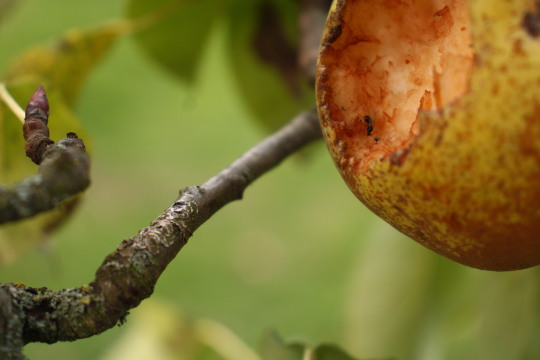
ay ay ay ay but what if i just

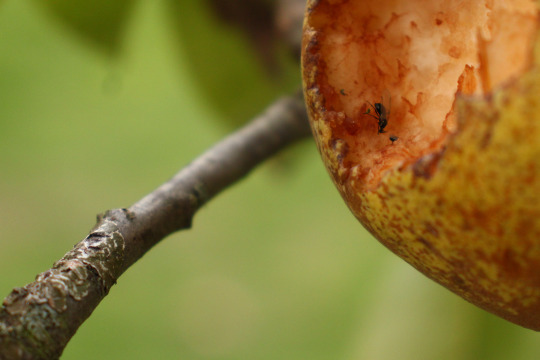
NOW with the power of gimp they do be lookin mighty nice
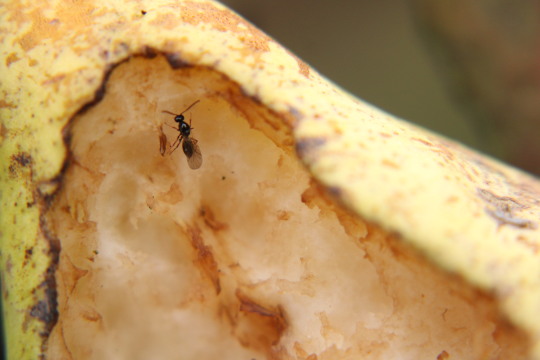

#photography#nature#autumn#bugs#macro photography#or at least attempt at macro photography#nothing a croping in gimp cant fix hohoho#the last one kinda blurry but i like it this way
0 notes
Note
Hi! I'm doing a project involving yellowjackets this summer. Any tips on getting them to cooperate/getting stung less often?
Howdy there!
For one, in general and specifically in my experience, yellow jackets that are separated from the hive are less likely to attack, especially around sources of food such as flowers, hummingbird feeders, honey, or fruit. They can be fairly easily coerced with the use of these sweet, fragrant things.
Social wasps are known to most positively interact with humans they see as a bringer of food, however, you don't necessarily need to give them food. The general rule of thumb, if possible, is to at least appear as calm around them as you want them to be around you, do not flail around or generally make fast movements that might be perceived as threatening to the wasps.
You can get closer to stinging wasps than you might think, with the right amount of experience! I've gotten some very close up photos of wasps and even held them in my hands without issue. However, a colony in their nest is, unlike a separated individual or small group, much more on edge due to the need to defend said nest.
ALWAYS practice the highest amount of care when dealing with nests containing a large amount of stinging insects. Take your time getting closer to the nest and make sure to give them space if it looks like they might be on alert and preparing for an attack. Over time, a colony that frequently sees nearby human activity and sees that said humans aren't a threat to them will slowly become less alarmed (you may even be able to notice this behavior change visually in that they don't raise their wings as much). Be very very careful when attempting to get close enough to the nest to take macro photography, and it may be best to also take any equipment with you during the process of calming the nest so they can get used to that too.
When it comes to minimizing the risk of pain from a sting, consider wearing thick clothing and other protective wear. This can be hard in the summer, as thick clothing and heat do not mix well, but dressing thicker when applicable and where you're most concerned about getting stung can be helpful. Also be wary of places on you where wasps or other stinging/biting creatures may be able to get into your clothes!
If all else fails and you do get stung, apply heat to the area of the sting. In the rare instances I get stung, I use a towel soaked in hot (but not too uncomfortable) water on the sting, this helps break down and render the venom far less effective and may relieve pain, itchiness, and swelling.
Happy observing and good luck on your project!
24 notes
·
View notes
Text

I pulled out all my camera shit (this isn't actually all of it) for national photography day or whatever the hell it is, and all I accomplished was making a big mess.
I actually wanted to see what other adapters I needed to get for some random old lenses to play with, but I'm now preoccupied with figuring out how to fit my OLD old FUBAR dropped-in-the-swamp macro EF-S lens on my current (EF) camera body. I want to take moldy grungy photos with it, or at least attempt to. There are no adapters due to mirror positioning issues, but someone said you can pry the plastic baffle off the lens mount and do some janky shit to make it work. The lens is trash otherwise, janky is fine.
anyway check out my dick

#text#photography stuff#I'm having a BAD time coping with some things so this is my distraction today#I have such a long list of personal photography work I want to do and less than zero motivation to actually do it#Shit sucks
12 notes
·
View notes
Text
Investing in a Digital Camera? Avoid an error With 7 Insider Points
So, you're ready to buy a camera, huh? Maybe it's a, it would be the fourth. It might still be an overwhelming and confusing venture. Because of so many digital camera models available today ranging in price from under $100 to over $7,000, it might feel as if you will find A lot of CHOICES!
Many individuals begin the process by investigating full functionalities and operations of Ten to twenty cameras in "their budget," however that is determined. Some individuals discover that process too frustrating and buy the very first digicam that "looks" right.
Personally, I'm an analyzer. Being a professional photographer, when I start analyzing digital cameras, it's like unleashing a sumo wrestler with an all-you-can-eat buffet... there is no stopping me.
But, for that typical consumer, understanding the digital cameras features alone just doesn't cut it. People would like to know What are the FEATURE DOES FOR ME!
Whether you go the feature/function route or not, you'll find 7 insider tips that will help save you money and avoid getting the wrong photographic camera on your purposes.
Tip #1: How to Get the Best Prices on Cameras
Wherever you are in the investigation/buying process, eventually you can this step. If you want to obtain a digicam, the most effective costs are on the net. Whether you've purchased anything on the internet or otherwise, there are specific INTERNET BUYING STRATEGIES which will save you money, time, and aggravation.
When selecting ANYTHING on the web, only look at the ENTIRE cost of the "digital camera + tax + shipping," Not only the price tag on the digital camera. Here is the best way that compares "apples to apples."
Once you see the top ENTIRE cost, do not immediately purchase it from that vendor! You can find key INTERNET inquiries to answer:
May be the photographic camera in stock? There is often a mysterious correlation relating to the cheapest digital camera prices and cameras being Sold-out. You dont want to order your digicam after which have it lay on backorder for 3 months, does one?
Does your Nikon (Minolta, Canon, etc.) include a USA warranty or perhaps it what is called "grey goods?" You would like to verify it's actually a USA warranty, unless you don't mind being forced to service it internationally. If it is grey goods, you WILL NOT be capable of service it in america.
When ordering your digital baby, beware of costly add-on accessories that may be needed eventually, but they are suggested with this "special order promotion time" at 200% with the normal price.
Tip #2: Professional or Prosumer... Which is Good for you?
Let's begin with clarifying our terms. An experienced camera is a dslr, while a prosumer is simply the rest. Because context, by no more 2005, digital SLRs may be purchased for $600 - $8,000 (Canon and Nikon, a minimum of). The true secret points to consider are:

If you intent to shooting night photos or other pictures in low-light situations, many prosumer digital cameras take good quality photographs at ISO 100 or 200. However, to look at good pictures in lower light at ISO 400 or 800 will typically have to have a dslr. Otherwise, digital "noise" will likely have too large a direct impact on display quality.
If you're planning on taking flash photographs at distances higher than 10-12 feet from your subject, an external flash unit needs to be used. Along with the only way another flash unit can be utilized along with your digicam is always to attach it in your camera's hot shoe. Every professional photographic camera carries a hot shoe. Many prosumers also do, but NOT Every one of them.
Salespeople often attempt to sway consumers faraway from professional video cameras into prosumer models, proclaiming that digital SLRs have so many complicated features that they are hard to use. Measuring only half correct. Digital SLRs are usually made to allow people to take pictures easily while using more automatic settings OR to use the advanced features when they are comfortable the process.
Tip #3: What is an easily affordable Digicam?
"Affordable" digital cameras have a tendency of developing your budget happy, but disappointing the photographer inside you.
Don't disregard the ergonomics from the camera. Would be the controls easy? Comfortable? The amount of buttons or levers have to be simultaneously set before getting the actual result you need?
In case you are upgrading from the more affordable digital camera, don't believe that spending more or having more features will automatically make you happy. Always check out you. An easily affordable digicam isn't affordable in the event you turn out not making use of it!
The brand new camera is much more than prone to operate differently than your older model. Will the new camera have controls which can be counter-intuitive? Things like that will frustrate someone enough to not use their photographic camera. Safer to find out details like these before as opposed to as soon as the purchase.
Tip #4: Do not be Tricked by Digital and Optical Zoom. Only One Matters.
Here's the conclusion: Optical Zoom may be the only thing that's important. Although some salespeople might argue using this type of, when choosing searching for camera, my suggestion is usually to COMPLETELY IGNORE ALL DIGITAL ZOOM FIGURES. Digital zoom has simply no influence on having the ability to have a photograph of the distant subject by zooming in onto it.
The reason salespeople like to include optical focus the equation is because advertising loves to supply you with the digital camera's "zoom factor." Multiply a 3X Zoom by a 5X Optical Zoom, along with a 15X Zoom factor... a totally worthless and MISLEADING number!!
Tip #5: Will be the Discount Digicam an excellent or Bad Idea?
The most important consideration when thinking about a discount digital camera (or another digital camera, for instance) would be to think about: "WHAT IS Come about?"
Many consumers begin by first falling in love with an electronic digital camera then become pleased or disappointed having its capabilities (usually as soon as they buy it).
I'm proposing something outlandishly radical... have the process the alternative WAY. First, ask yourself some basic questions:
So what can I do with all the camera (and do not say "take pictures")? Precisely what are you most considering - the rare family snapshot, landscapes, macro work, heavy flash use, the above?
Just how much use does it get? (Twice yearly, or once weekly?)
Precisely what is most significant if you ask me: display quality, camera size, camera weight, durability, telephotos/wide angle lens, etc.?
Determined by your responses to these questions, a discount digicam will probably be your best choice or even a complete waste of greenbacks.
A "no-name" discount photographic camera is usually a logical choice, based on what your photographic goals are. Try not to think a $49.95 Brand X camera will almost certainly run you $49.95! You also have to incorporate within the cost for at least some accessories, such as memory, batteries, bag, and lens protector.
Tip #6: When are Small Digital camera models an ideal Choice?
Despite impressions to the contrary, small cameras (generally known as compact digital camera models) can be popular. They're convenient to carry, usually loaded with features, and take respectable photographs.
We need to remember that SMALL Does not imply UNDERPOWERED. Some benefits of going tiny are: less bulky, easier to transport, less conspicuous (less inclined to "walk off"), and so they often compare favorably with larger cameras within the feature and price categories.
A number of the pitfalls of going small include: possible trouble physically operating a few of the camera's controls, less inclined to support an external flash, as well as the physical size can limit a number of the available features, like image manipulation.
Tip #7: Megapixels - What's Fact; What's Fiction?
Megapixels is among the most mentioned (and misunderstood) terms in the world of cameras. Let's sort through some facts and misperceptions, to help you create a more informed purchasing decision.
Taking better digital photography involves more than just creating a camera which has a lot of megapixels, even though you wouldn't realize that listening to digicam salespeople.
Megapixels is simply one aspect in creating better photo digital portrait photography. And, you cannot see it alone. You should consider other photographic camera features.
How soon or slow the camera's shutter speed may be set is vital. Employing a tripod, to be able to manually set the white-balance control, inside them for hours pre-programmed modes to aid in tricky lighting situations are very important factors in achieving better portrait digital photography.
Do not get the thought that megapixels could be unhealthy, or irrelevant. This is simply not TRUE. There exists just one area where more megapixels can establish better photo digital portrait photography results. If everything else is the identical, more megapixels will provide GREATER FLEXIBILITY TO CROP A photo whilst still being turn out having a sharp clear photo. And, cropping photographs can produce a whole world of difference. Cropping will be the eraser on the digital pencil.
Conclusion
People will make investing in a camera easy decision or a life-long project. With there being numerous models, brands, and features; it could get pretty confusing. You will not ever understand all the FACTS to really make the "best decision." But, basic 7 tips, you will be aware what really matters for your requirements.
For additional information about nikon digital camera dealer take a look at this website.
1 note
·
View note
Text
Dandelions
There are a handful of photo projects I have been intending to get around to for some time. Some such ideas have been sitting on my to-do list for years but, as is often the case, means, motive and opportunity do not always align.
One such concept involves macro photography of dandelions, which are a nice, traditional thing to photograph in closeup. Some opportunities have come close in the past – one weekend I realised some dandelions had sprouted in our front garden, but before I could get out and do anything about them, our neighbour decided to be helpful and mow the grass, taking out the dandelions with it.
Luckily one lovely spring weekend day last year I noticed some dandelions sprouting again, so I took the chance to get some shots of them.

1/500sec, f/2.8, ISO 100, 100mm
The chances of dandelions growing exactly where I wanted them was pretty slim, so I picked them, took them to a spot in our back garden, and propped them up by clamping them to a bucket.
As you can see, it was early spring and my garden was looking pretty overgrown, which helped give me a nice green background to the shots (but before you say anything, after I’d finished taking photographs, I did mow the lawn).
My plan wasn’t just to take macro photographs of dandelions. As nice as they look in macro, it’s not quite enough to make a compelling set of images. It was always my intention to do something more, in order to make them a bit more interesting. Something which might seem, to some, a little destructive, although if vegans are allowed to eat plants then this is probably morally fine as well.
Anyway, point is I decided to set fire to them.
The plan was relatively simple. Set my camera up on a tripod with my 100mm macro lens, clamp a dandelion in the right spot, set the camera to burst mode, and use my remote cable to fire off as many shots as the camera can do for the second or so that it takes for the dandelion to burn.
My first attempt I missed the fire completely.

1/250sec, f/2.8, ISO 100, 100mm
Even though I missed the money shot, I really like the faint glow of the smouldering remains of the dandelion combined with the smoke – something which may become a bit of a theme in this set.
For the next dandelion I struggled to get positioned in the right place. The stem was a little limp, meaning it had to be clamped a bit lower, meaning the bucket I was clamping to ended up in shot.
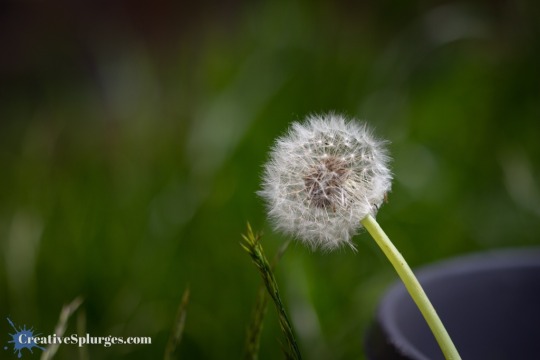
1/1600sec, f/2.8, ISO 100, 100mm
I did a lot better at catching the fire this time, although as you can see the lighter I was using was in the shot.

1/1000sec, f/2.8, ISO 100, 100mm
When editing I decided it was worth cleaning up the shot by removing the lighter in Photoshop. My first go using the Cloning Stamp tool was not bad.

1/1000sec, f/2.8, ISO 100, 100mm
With a rapid-fire shutter I managed to capture the whole thing going up in flames nicely. When you’re dealing with something like fire there is a big element of luck, because you have no idea or control over where the flames are going to go or what they will look like, so you just have to fire your shutter and hope for the best. So I got a bit lucky with this next shot.

1/1000sec, f/2.8, ISO 100, 100mm
This shot again had the tip of the lighter in frame, and I quickly started getting a bit lazy with removing it, and resorted to using Photoshop’s often quite remarkable Content-Aware Fill to paint it out in one go. It worked really well, you have to look pretty close to see the rough edges. Certainly it did at least as well as I did with the Cloning Stamp tool, so why bother wasting my time?
Even with the camera firing at full tilt (which a quick internet search suggests is just over five shots a second), it was all over very quickly, and I was again left with the glowing embers of a dandelion.
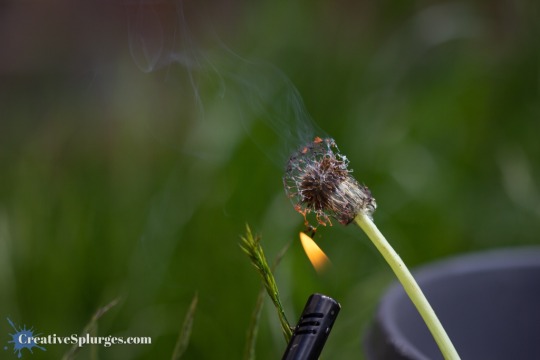
1/1000sec, f/2.8, ISO 100, 100mm
I did catch one little moment, if you look at the lower centre of this next shot you can see a single, smoking dandelion seed falling out of frame.

1/1000sec, f/2.8, ISO 100, 100mm
I lined up another dandelion, quite a pristine example. I managed to again get the bucket in shot thanks to a weak stem.
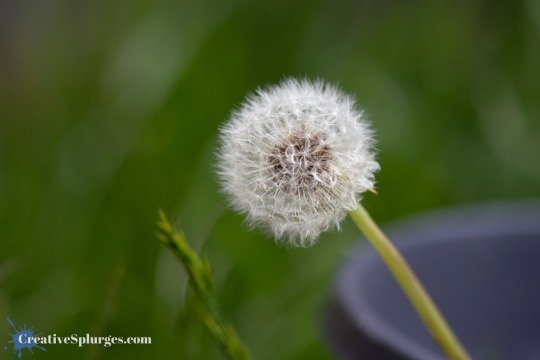
1/1600sec, f/2.8, ISO 100, 100mm
You know the drill by now: set fire to the dandelion, fire off shots on the camera as quickly as possible.

1/1600sec, f/2.8, ISO 100, 100mm
The next two shots, I’ve once again used Content-Aware Fill to remove the lighter tip.

1/1600sec, f/2.8, ISO 100, 100mm

1/1600sec, f/2.8, ISO 100, 100mm
As you can see this dandelion burned differently to the last one, it turned charred a lot quicker and I didn’t get the same half-burned, half-pristine dandelion shot as with the last one.

1/1600sec, f/2.8, ISO 100, 100mm
My next dandelion had a stronger stem so I could get the bucket out of frame. That said, I managed to position it so high it was above the grass and you can make out my garden wall in the background. I also closed up the aperture from f/2.8 to f/5 to make sure I was getting more of the dandelion in focus.
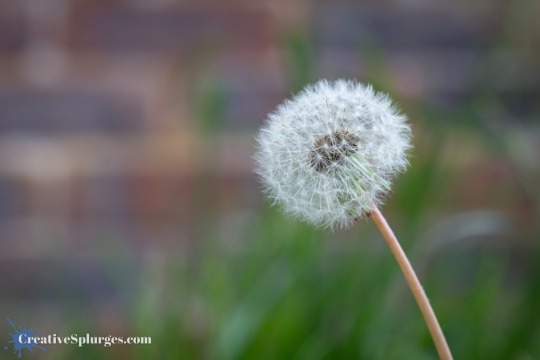
1/160sec, f/5, ISO 100, 100mm
I still got the lighter in frame, but Content-Aware Fill continued to do its work.
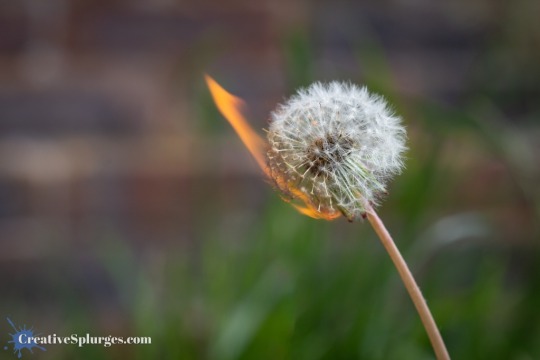
1/250sec, f/5, ISO 100, 100mm
For just this one shot I got a bit creative and put the photo though Analog Efex to see what the filters should do to the colour. The fake analogue damage, to my mind, adds to the look and it seems to make the flames pop.

1/250sec, f/5, ISO 100, 100mm
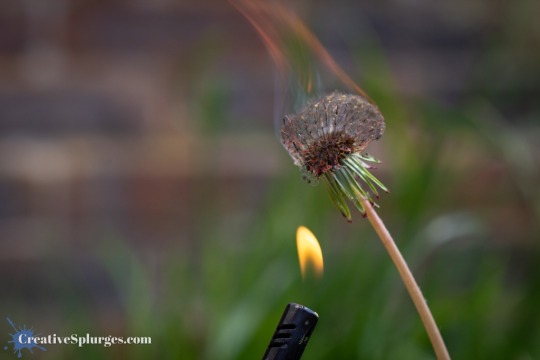
1/250sec, f/5, ISO 100, 100mm
As with many of these shots, sometimes the glowing, smoking epilogue of the main fire is at least just as interesting.

1/250sec, f/5, ISO 100, 100mm
I framed the penultimate dandelion slightly differently, easing in to the other side of the frame. I still brought the flame in from the left though, to see if it all burned in a different way.

1/200sec, f/5, ISO 100, 100mm
Annoyingly I think I knocked the flame setting because it was a lot shorter than the previous shots, meaning I had to get the lighter much closer to the dandelion to light it up – which made me decide against removing the lighter in Photoshop.

1/200sec, f/5, ISO 100, 100mm

1/200sec, f/5, ISO 100, 100mm

1/200sec, f/5, ISO 100, 100mm
I positioned my final sacrificial dandelion in a similar spot in the frame.

1/400sec, f/5, ISO 100, 100mm
This time I did better at positioning the lighter out of the frame and so no Photoshop shenanigans were required.

1/400sec, f/5, ISO 100, 100mm
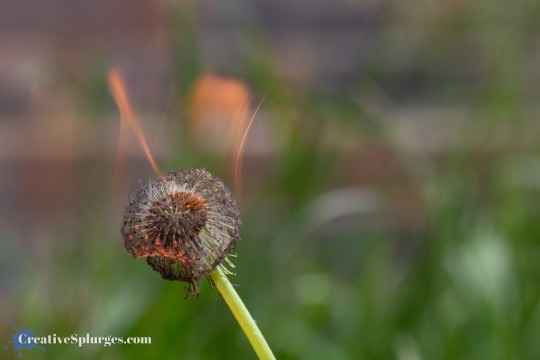
1/400sec, f/5, ISO 100, 100mm
For whatever reason this one didn’t fully burn in one go, leaving some bits intact and smoking.
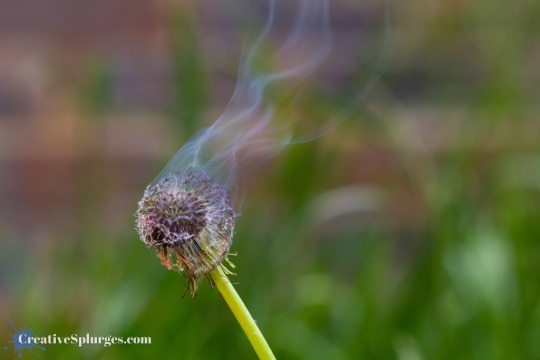
1/400sec, f/5, ISO 100, 100mm
I had another go at burning off the rest of it but not much photogenic came of it.
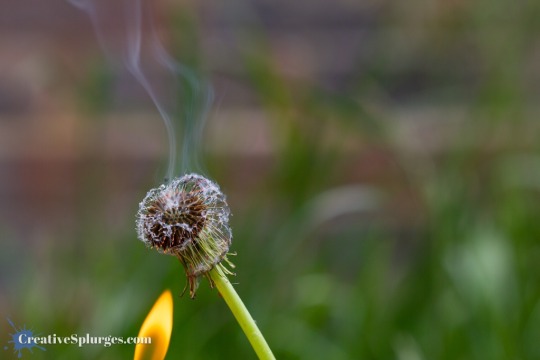
1/400sec, f/5, ISO 100, 100mm
And with that, I was out of dandelions.
I’m pleased with how this one went. I love some of the results, especially the shots where some of the remnants of the dandelions are still glowing red hot and giving off pretty wisps of smoke. It was also good to get round to shooting a little project like this that requires setup and planning, something I used to do a lot more in the earlier days of this website but haven’t done in years.
Every so often when I see a patch of dandelions in my garden or near my house I think about doing this again, but as is often the case with these little experiments of mine, I try it once and move on. Still, I’m not adverse to playing about with fire some more in front of my camera.
from WordPress https://ift.tt/yavi0cn
via IFTTT
0 notes
Text
An Interview with Tavis Amosford
Jaime Molina: Please introduce yourself.
Tavis Amosford: I'm a Devon based artist and have been here for a large portion of my life having originally come from London. I've been interested in photography since September 2014 when I got to play around with an old analogue camera that I had picked up from a car boot sale. Currently I'm working on 2 projects one I can't really sum up apart from that it will revolve around a recent obsession with moths. The second project that I'm focusing on at the moment Is an exploration into Devon's folkloric customs and how these relate to the landscape in which they inhabit.

JM: I really want to know more about the first project. Could you talk a little bit more about it? What is it about moths that interests you so much?
TA: I started to get the idea during the first lockdown as I was dissatisfied with trying to work on my project on folklore. I found I was unable to get out of my city and thus to the locations of interest. Out of this I started to experiment with more localised photography such as still life within my own home purely as a means of expression and to keep focus. The main interest in moths as a central theme for the work comes from the short essay The Death of The Moth by Virginia Woolf, which explores the futile yet powerful attempts of a moth to cling onto life whilst in death throes.
The essay is set from the perspective of an onlooker, I became fascinated with the connection of the micro with the macro. As Well as the connection Woolfe makes to our own situation on this planet and often the beauty in the futility of will power in the face of certainty. The project is very much a metaphorical exploration into the life cycles of moths in relation to our own sense of purpose.

JM: This year has been tough for photographers as we haven't been able to travel and produce work outside our everyday environment, how has the lockdown affected your practice?
TA: I think lockdown has definitely caused me to reevaluate my practice especially in terms of how I want to see it progress into the future. I would say the main change is that I have become more critically aware and have become dissatisfied with trying to box myself into an artistic category. It's hard to say exactly how it will manifest but I don't want to focus on purely documentary or even just photography for that matter as I move forward.

JM: What work are you looking at to get inspired? and what other art mediums would you like to explore?
TA: I would say that "Sleep Creek" by Dylan Hausthor and Paul Guilmoth has been hugely inspiring. Especially in terms of their approach to photography as a form of world building. Apart from photography the Sculpture Gardens of Veijo Rönkkönen have piqued my interest lately, There's something about the juxtaposition of his reclusive lifestyle with the mass of work he created that shows a passion for art completely separate from our modern people pleasing art world. This is something that I've found a lot of inspiration from for my own practice.
I've always been into a wide range of different mediums although more centring around reproducible arts that allow for printing, whether that's photography or Lino. I think that in the future I would like to explore an art form such as pottery which is heavily about the creation of a one-off object.
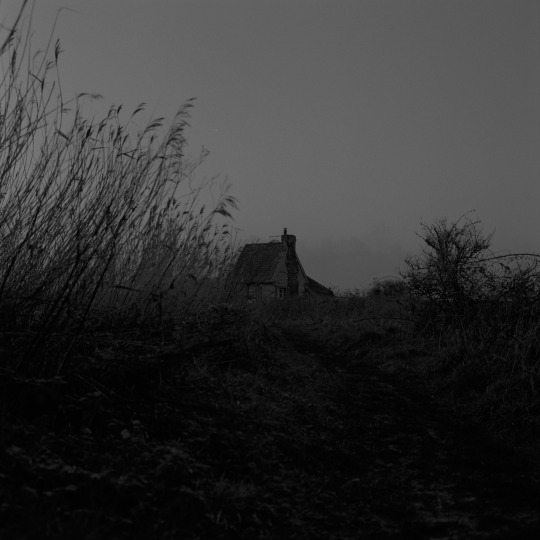
JM: Why is it important for you to challenge the current/modern perception of art?
TA: I think at least in terms of the art I produce and like to consume, that to some extent a lot of it feels as if it is falling into a mould or at least has a very similar progression and trajectory of evolution. I believe this is predominantly a mark of social media as well as the societal pressures of making a financially sustainable practice. This also forces conformity in terms of censorship and social norms, whilst also gratifying you for providing images that the largest amount of people appreciate. For me it becomes important to question this modern perception of art, mainly out of annoyance at how comfortable it feels to produce work I subconsciously believe people want to see. Within future work, I hope that I can break away from any notions I may have as to what I should be creating.
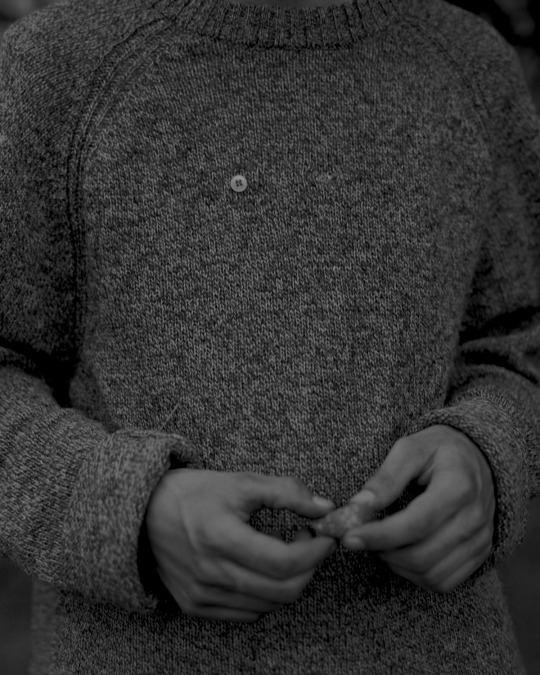
JM: Why did you submit that image to LTRF?
TA: I would describe my image as a quiet moment, it feels mundane yet almost nostalgic in subject matter. I enjoyed how the pairing almost began to create a narrative link between the two, being that the other image also felt sombre. I was also drawn to the juxtapositions in textures and tones between the fabrics of both images, they just had a very natural flow.

JM: Lastly, What is your favourite moth? & If you could give yourself any advice right now what would it be?
TA: I definitely have to go with The Death Head Hawk moth, purely because of how uncanny it is that they have a pattern resembling a human skull on their back.
In Terms of advice, I would tell myself to experiment more and to not necessarily worry about how it will fit into a larger body of work.
___________
Tavis Amosford https://www.tavisamosford.com
Let The River Flow on Instagram
Issue 2. Available to Pre-Order now.
0 notes
Photo










Let’s Try Again
So, today I am seeing what blog provider Tumbler, is like as far as photography related blog posts are concerned. Eventually I will hit on something that works for me. A place dedicated to free speech, but is also handy for publishing photos. I am (0bviously) struggling to mate images with text. I will get it eventually.
This particular post is meant to be one of those “this and that” type of illustrated articles that I enjoy doing.
Photographers can get as caught up in being singular in the style and themes they use as is the case with any visual artist. Shoot the same subject the same way day in day out. That way we are sure of ourselves. When I taught photography, I was always worried that I would not have the time with a student, to express the joy of looking at any given type of subject in many different ways. Plural intent so to speak. Absorb ourselves in one style or type of imagery with a given subject, until we have a few “in the bank” so to speak, and then find another way of “seeing” the subject.
Dramatic light on the land, is a popular and obvious way to envision and then capture a landscape photo. While planning and then waiting for that light to appear can take time and patience, the results are usually worth it.
This image of the Guadalupe Mountains of West Texas was created in the afternoon when the light was rich and warm. The color and the contrasts of shadows which are born of the low angles of the sun which creates shadows, are more powerful (my opinion) than even ten minutes earlier.
This image of Monument Valley Arizona/Utah was created when the sun was even lower than in the Texas image. Those rock forms jut into the sky just high enough capture the final rays of the day. Drama personified.
Most photographers seem to view wildlife photography quite differently. That’s understandable but never over look the idea that what makes the land powerful can do the same for wildlife.
Below, the warm light of sunrise bathes this baby wild Sandhill Crane by creating an inspiring, mood provoking appearance.
What about the very edges of light and dark. That light is not made only for rock forms.
This Snowy Egret was dancing in and out of the shadows as it went about the chore of searching for breakfast. This image has been highly successful in creative photography groups. Usually a wildlife image of a wading bird fishing, would only be admired in traditional wildlife groups. Light matters!!!
When it comes to wildlife, how close you are means a lot. As photographers we spend a lot of time, energy, patience and money (long lenses) on making wildlife images up close and personal.
An image that takes up a high percent of the picture frame, will always be a winner with future viewers of that photo.
This Common Loon is a desirable subject and the image is enough of a close-up for viewers to immerse themselves in the world of the loon.
True full body shots of a colorful bird like this American Kestrel are always popular and powerful in their presentation.
The closer the better? Often times yes.
This even closer image of a wild adult Sandhill Crane not only shows in detail what the face and head of this species looks like, it is personal. We feel like we know this bird personally.
While close-ups are personal, they lack a “sense of place” and habitat belonging to our subject.
This female Elk with her half grown baby tells us a story of the animal in its habitat. The trick was to wait for a moment when together, they struck a pose that “flattered the image“. It’s even more likely that I made a lot of pictures of these two and this is one that I like best.
Sometimes a sense of habitat is more important than other times.
I felt that was the case with these Bighorn Sheep grazing in a area that was just outside of the rock forms in The Badlands National Park, South Dakota. You know exactly where these wild sheep live.
Close-up images of flowers is popular with a minority segment of nature photography. Not a small minority, but a minority. It was one of my personal favorites.
If you look at a flower compositionally, just like any other subject, you will find that macros of such lend themselves to the same sort of compositional decisions as those other subjects.
Normally I favored photographing the type of flower you see below, using the same kind of rules (there are no absolute rules) as I would a landscape or even architecture. The rule of thirds, power points etc. I used those rules below but this image has never been more than “so-so” for me. I never fully warmed up to it.
Light, color, detail and contrast. That’s what I’m talking about! Bringing several elements together in one image, can be done with a close-up of a flower, just as it can with the land in the high desert of Utah.
The dramatic side light in the image below, creates definition for the dew drops. It gives them a sort of texture. The composition is about giving credence to what is the closest to us, and slowly diminishing the rest into the darkness.
I hope you enjoyed today’s post. It feels soooooooo good to write about and illustrate photography again.
For the time being, I will attempt to improve on what I am doing here, and keep Wordpress as a text only site. At least until they “show me the door” for good.
God Bless,
Wayne
0 notes
Text
Reality Patch
(3393 - long read, messy, technically ‘unfinished’ whatever that means)
There was a little bubble of interest in the Miu Miu pre-fall collection in the twitterverse a few weeks (months? years?) back – it seemed torn out of time. Made in the winter, shown to press in January? Viral in the early summer? To be bought..… sometime? Part of the issue is the term ‘pre-fall’. Pretty certain that’s summer. This collection feels like it doesn’t exist. I guess if I ever went shopping, it would make more sense? But as a broke hut-dwelling internet denizen, I’m lost. It’s this money-spinning side to fashion commerce that’s the ‘real’ collection, but it’s named after a non-existent season. The pre-fall/resort problem lies in that it’s the collection that gets the least press, because not normally presented in a show, but also functions more solidly as merchandise. Certain agitators want to eliminate these non-events, and revert to twice-yearly seasons. It’s a fucking mess. What even is this? The fashion calender is broken and illogical. I’m going to write here about the Marni AW 20 ‘Alice in Wonderland’ collection alongside Moocher’s pre-fall thing, because I’ve got queries about patchwork and they play well together.
I have …complicated… feelings about the patchwork. We’re probably going to see more and more of it and I’m not sure we’re asking the right questions of it. How do we avoid it becoming just ‘aesthetic’ (in pop speak = empty), rather than a manner of process that informs continual work going forward and results in an un-replicable feeling, a new angle on reality (an….. aesthetic). How to stop it becoming something we all get bored of? Because, the only guarantee in fashion is boredom.

Patchwork collage
Miu was a solid offering – it maintains a certain quality, obvs – and is good in its own way according to its own logic as Miuccia’s offerings usually are. A vision of commerce, yes, but also a kaleidoscopic frozen moment of girlhood that wants to aid us in our navigation from then to there, the ‘there’ being an upcoming un-season (A/W/S/S?) and maybe a sense of maturity. Now, there’s no point in me complaining about low quality info from the establishment on their dealings then failing to engage thoroughly with work when it is delivered in detail on multiple fronts (written aspect, full campaign, video that I can’t find anymore but remember seeing unless it was a hallucination, and look book – many angles).
Embellished bodices/check check/white fuzzy tights/nice shiny heels/19th c take on afghan jacket very good/prairie psycho/much boring merch – (awkward stances suggest candid, ambivalent)
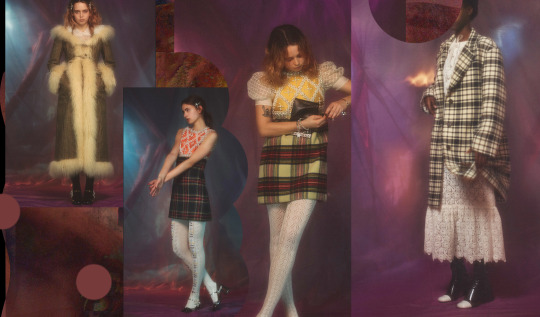
Miu look book Collage
Our press release ponders:
‘When was the last occasion you lived in an enclosed world, where time stretched out, seemingly endlessly, in front of you? When was the last time your interior world felt as important as the exterior one, where you were free to imagine and to contemplate who you might actually want to be? Chances are it was when you were a teenager, with all of the triumphs and trepidations that entailed, particularly if you were a teenage girl.’
Well, it sure sounds like it sucks to be a real adult who gave up on their dreams. When was the last time I felt free in my internal playground? Every day of my life, bitches. I’m your anomaly, Prada copy-writer. But, point taken. Work sucks when you’re doing it for other people, and we’ve all had times when you feel caught and pinched and empty in our creative attempts. And now, we’ve all been grounded by our stupid parents for the last few months. Stuck in our rooms. Some by choice, some not. And if we’re allowed out right now, the second spike is coming and we’re all depressed about the limits we have to live under in order to reduce advancing death.
‘A dream-like, interior world is conjured through Douglas Irvine’s photography to match the external, magical manifestation on display in the clothing. A blur of florals and glittering visual embellishment, diaphanous drape and ecstatic movement belie the strict foundations for both the images and garments.’

campaign collage
So far, so wordy and detailed. A world is glimpsed. One with blurs but strict foundations. A real world made hazy. We have classic codes walking in a trepidatious vein. Miu Miu girl is testing out the limits of her horizons, playing with her identity through her clothes and thinking to herself, how much do I want to give away? What will I keep? But the text continues:
‘Wearing a clothing collection that splices the utilitarian with the formal, the everyday with the extravagant, delicate artisanal embellishment is contrasted with and applied to a notion of the sturdily homespun. Here, nineteenth century literary heroines, both fictional and actual, are channelled, the sources of teenage-girl bedroom revolutions in both style and substance, yet worn by a new generation of everyday heroines with all of their contrasting clothing choices.’
We lose track here. Not sure this collection actually feels ‘artisanal’ or ‘sturdily homespun’. there’s the late 20-teens pop refrain of dark psychedelia’s fixation on moth-eaten fin de siècle grandness, the upending of 19th C avant-garde in the counter-culture’s looping democratisation. We have an eclecticism, a thriftiness, a carelessness with the past symptomatic of isolated children playing with a mish-mash of pieces born of hemmed-in theatrics.

3 MIU PICS
MORE – CAMPAIGN/POSES/FACES/DESCRIBE CLOTHES – here comes what night?. Colour, focus. Don’t really like the clothes, wouldn’t wear any of this tbh.
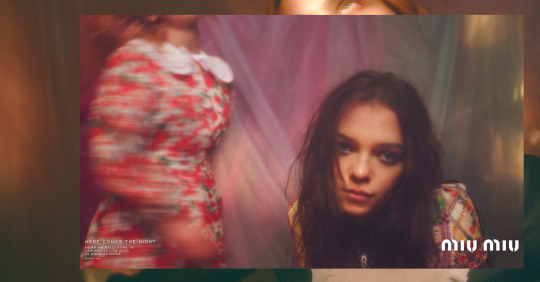
CAMPAIGN PICS coll
As for Marni’s Alice in Wonderland, I have languishing notes which seem as old and tired as the idea of 2019. I was practising twitter threadiness, and got as far as notes on Milan before the covid freeze set in my mind. I like mixed responses, it’s the only thing that feels fair, but with those Milan collections I couldn’t achieve any sort of resolution or clear point. I didn’t know how I felt anymore. I’m unresolved in how I feel about criticism. It should be functional, but not necessarily constructive, if I feel the need to tear something down, as a critic that is within my job description. I’ll write a proper bit on the perils of fashion criticism from a distance, but in short I feel that it’s unfair to criticise a designer’s work from afar, especially negatively, but that until the fashion community realises the value of a public culture of critique (criticism being the only process by which you can hope to form an art system), real critics engaged with honestly parsing the strengths and weaknesses of fashion practice in service of public health will have to criticise from afar. This will impact the quality of the work, but it is hoped the audience can accept the pinch of salt required of virtual critique of a virtual fashion experience. The subject of the criticism here isn’t the clothes. I’m not asking questions of fit, of quality, I’m asking whether this is good fashion communication, as a time-dependent media phenomenon. And, yes, I know I’m late on this one. Temporal fashion stress must take a rain check at present.
Marni –
“collaged from the beginning to the end—from macro to micro to fractal. It’s about putting together remnants.”
cut velvet woven by hand in a factory in Venice on looms that were originally designed by Leonardo da Vinci—a vanishing, time-consuming craft that Risso understandably wants to “protect and exalt.”
“Are we in a psychedelic world and we need to be more grounded, or are we in a caged world and we need to be freed by psychedelia?”

THREE MARNI
risso Quotes:
“Finding beauty in the leftovers,”
“There’s a beauty in the past. I was kind of upset lately, thinking about people on their phones -- what about these objects that take hours to make, like these Venetian tapestries?”. mosaic of the remnants.
new, conceptual territory,
remnants of the previous collections
“It’s a celebration of DIY, Alice in Wonderland, and it’s about her spirit, her searching and questioning,”
the Cheshire Cat’s “We’re all mad here” mantra, as he talked about mandalas and allowing time for ideas to grow.
“Her spirit is within each creature, always wondering and questioning,”
“Making this collection has been the strangest mystery,” he confided. “It’s almost as if it regenerated itself – recreated itself – like an insatiable mosaic.”

THREE MARNI
At their best they’re the insatiable fractal mosaic he speaks of – something that situates you betwixt density and freedom. Was patchy – moments of clarity, moments of aimlesslness.. Appreciate the fashion-as-curious-adventure methodology. Ties and openness and rotation were true to Marni.. Materials – twisted tradition meeting rational plain cottons hit the mark. Gold rings, like they’ve melted through from another dimension. They were scattered over the body, but I was left wanting to know more of this motif – what if it become structural, like a portal to another plane? Patchwork that doesn’t feel done in good faith. Like a trick. None of these shapes are done in the spirit of patchwork, like the wrong kind of luxury. Too much care is given to appearing careless, but a reach for dizzying angles in effect sidelines affect – it feels tidily resolved, and then mussed around at the end. I’m probably wrong on many fronts about the reality of their process. But what I’m feeling right now is that if all you’re aiming for is the ‘look’ of patched pieces rather that the ‘ethic’ or process of thrift, then you’ll just get trapped in an endless empty labyrinth of false choices. It’s not about the look, it’s about shiftinG your total parameters of design decision making going forward. Additive.
I’m still figuring out how I feel about this. Both these collections suffer from a neat, pat resolution of the question of the deadstock aesthetic that avoids the hard work of engaging with the limitations of that mode of work. Where is the tension? Where is the sacrifice? The loss of freedom in thrift must be acknowledged. If you’re telling me a story about a lost girl in a crazy world that makes no sense, why do her questions of her physical environment feel so impersonal? Many designers are going to turn to patchworking, out of both necessity and fashion gameplaying. Each designer is going have to work their way to an individual conversation with the difficult questions of recycling while avoiding the traps of the easy way out. Both teams failed at this test, in these collections. Sustainability isn’t easy, or anywhere close to being properly engaged with by our establishment figures. (Viktor & Rolf are a good example of recycling feeling right and thought about and cared for).
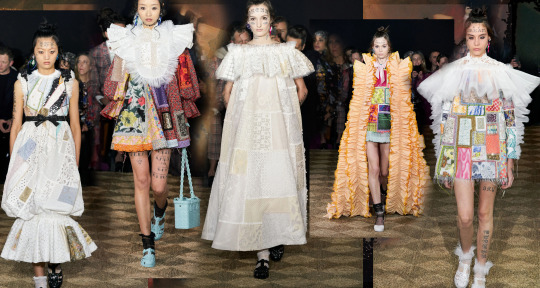
Viktor&Rolf samples
I’m reading Lolita at the moment. (CAN YOU TELL?) I’m not a good reader. (CAN YOU TELL?) A.D.D., I guess. I get bored and drift off to fantasyland. But here’s a stab at some fancypants analysis: The far-off subject, Lolita herself, is overlooked by the narrator’s masturbatory myopia. Her exploration of her own girlhood/womanhood is reduced and flattened by her abuser who needs her to be something else, something thing-y. A two-dimensional being. The tension between predation and autonomy, her wounded rebellion and navigation of self are so distant in the book you can’t help but want to reach out to her, through her abuser’s hideous twisted lens. Humbert’s POV colours everything, Lolita isn’t permitted her own take, everything she does is ridiculous and gazed down upon, he feels he’s permitted to just take her, to prioritise his own long-abated lust without thought of the consequences to her sense of self.
This vibe I’m analysing here, the bruised and fuzzy self-discovery of Miu Miu and the lost-play of Marni, kind of feels like it hasn’t really shrugged off the top-down, hidden, extractive gaze of the cornered, self-pitying male power player. Maybe the viewer is Humbert. Maybe I’m Humbert. Maybe you’re Lolita. Maybe vice versa. But he’s there, in the corner, or taking the picture. Someone’s always taking it in, and jealously building a crypto-fantasy version of the girl, even as our self-birthing adolescent is feeling towards a way to fight it off.

campaign
Spring 2020 was a fucking twisted, disorienting, stretched moment. Tough times for fashion practitioners, not just in terms of lost profits or mob moralising (pppeoppllle arree dyyinnnngggg howww daree you talkkkk aboutttt fashioonnnn) but in the nuts and bolts of fashion practice – if the role of the fashion designer is to collaborate with their wearers in plotting a path to the future, when a world-re-orienting catastrophe occurs, it rapidly recontextualises their attempts at constructing a scaffold around the unknown. The idea that the future can be planned for and known through schedules and aesthetic anticipation gets rumbled. The foundation of that building site got a bit cracked during this Spring’s quake. Mapped onto ongoing structural issues in, what I guess in this analogy is a renovation of our historic temporal orientation casino, basically fashion collapsed in its usual confidence along with the economy (economics being fashion with numbers and no fun so it’s respectably masc. vom). Who knows who’s going to go out of business. There may not be a Miu Miu or a Marni or whoever in the future. Names we take for granted are just going to die. That’s a loss for the art aspect. Cus these guys are creative, mad geniuses who deserve a healthy context for their vision. (OTOH: die, fashion industry, die! I dance in the glow of the flames of your destruction with gleeee). These two collections actually speak to me across the span of the last six months, which takes some doing. They succeeded in the criteria that we should actually apply to fashion practice: satnav for the social soul. As sense of protection from the twists of time. A hand to hold. Someone to talk to. And time is super twisty rn. Good job holding on as we fall through the looking glass, random Italians! Now, to work.

COLLAGE
Colours – piecework – slippery glistening rainbow lensflares – Marni, FR places himself as an agent of chaos, someone with a hidden explanation refusing to submit to logic and set ways, a spanner in the works of Alice’s complacency.
Patchwork, rhizomatic? (????, what is that. Idk, just sounds funnnn), no beginning and end, things relating to one another in disjointed, flexible ways. FR gives is little hints at the instability that patching offers, the early looks in Miu are far too comfortable. In the cut, sheets are formed out of set shapes – traditional, in the spirit of that half-remembered literary heroine – but neat, very very neat. Happy patchwork . Not patchwork that’ll prompt you to any alternative engagement with your world. FR is poking holes, even burning them out with molten gold, playing with the limits of ‘traditional’ or easily molded pieces. There’s skirts that feature block pieces - an armhole, a curve that any dressmaker will recognise, but set elsewhere, surrounded by other pieces so that the shaping becomes as redundant as Alice’s desperate attempts to right her upside down world. That ordered, shaping impulse is pawed at in the Marni work, but indulged in by Miu Miu. Our Miu Miu heroine feels more like an only slightly misunderstood brat, but Marni’s Alice is strung out and barely even human anymore. I’m disappointed in both approaches, but Marni, as the radically abstract collection that’s pushing concept on us, is the one that actually fails in its aims. Mrs Prada & Co are aware of the limits of commercial offerings. They’re happy to speak when permitted, in the lulls between commerce. It’s pragmatic and unadventurous, romantic within set bounds. It’s a walk in the park, where Marni is a clumsy trip through an open manhole cover.

COLLAGE
I said at the beginning of this that if we’re only going to see more patchwork as a process we actually have to grapple with it, and there’s a risk at this point in fashion that the fashion people (c’est moi aussi, mfs) are going to go ‘oh, been there, done that, on to the next thing’ without ever actually engaging with it as a means of creating fashion. What does (BRANDNAME) recycling look like, what makes it (BRANDNAME) in a way that become part of a lexicon long term rather than another sticky-plaster? Patchworking is many things, but what are its fundamentals? It’s a way of forming textile surfaces that accepts that which is available. It’s humble and more concerned with ethics than end result. The small squares/triangles in traditional American quilting are ways to systematically optimise waste pieces and merge them with other pieces. This in its own turn creates more micro-waste, perhaps to be used as stuffing, but forcing scraps into legible grids is very strict and imperial, the grid being an easy way of organising a surface from above. Grids and precise geometries are more like things overlaid, not bubbling up from beneath. They’re simple and readily comprehensible. There’s other forms of merging irregular pieces: think of rag-rug like textiles, crocheting with strips, or applique. Certain aesthetic choices can be made when you’re actually working with the idea of recycling waste material, rather than looking for an end-result before you even started. A cut piece has an end but with patchwork it can become endless. There’s kind of something anti-hierarchical about it. Waste pieces formed out of negative space can relate to each other not in the sense of ‘this looks pretty’ but more in the sense of ‘spontaneity rules’.
I’m realllly self-consciousness about existing in the purgatory between between fashion and theory. Theory thinking of itself as ‘too serious’ for fashion and fashion of itself ‘too fun’ for complex discussion (sidebar: can we stop talking about showstudio as if it is in any way innovative? I can’t watch those videos. I have classic fashion goldfishitis. Where is my colour and jazziness and silly nonsense. Why tf do fashion people think ‘oh, critique! must be unfashion. Must sit in room being boring with no cuts or editing. Here, watch a fucking zoom call, fuck your need for beauty.’ The motherfuckers are working against us. Hate, Hate, Hate, you fucking jerks). So, my difficulty lies in how to dodge the hierarchical perception of theorising, people assuming you’re talking down rather than across, when they’re often dyslexic or disinterested in this kind of stuff because they’ve been taught to think it’s ‘beyond’ them or it’s just some bullshit they’ve found boring/embarrassing/trauamatizing. There’s nothing wrong with finding something boring when it’s engaging in elitist and hierarchical perceptions of ‘intellctualismsm’ or ‘quality’. There’s so much work to do, so much rubble to excavate. I’m not writing about Deleuze & Guattari’s analyses of patchwork for a reason here: I haven’t read them. I attempted A Thousand Plateaus in undergrad, gave up, and since then have really struggled with this feeling of being caught between modes of being - visual/verbal/temporal. Fashion zonked, theory enraged. I have a deep respect for the communicative power of dress and fashion media, paired with immense frustration at the slight engagement with complexity in the culture. Theorizing can be colourful, can be fun, can be bright. Fashion doesn’t need to abandon these wonderful things in order to have some self-respect. In fact, its self-respect will only be assured when it learns to push forward towards aggravating, complex dialectics in its own styles of discourse that fashion people actually want to engage with. I expect at some point within the next decade I’ll find a way to develop my self-confidence in reading beyond wikipedia and want to return properly to the topic of quilting and patchwork in relation to rhizomes and abstract post-structural philosophy, but I’m not there yet. Maybe there’s nothing there in D&G, just hot air, or maybe fashion isn’t worthy of theorising. Both suck in various ways. I’m not confident enough in the theory realm to interact with any self-assurance in a way that computes in both worlds. I’m only just learning to piece myself back together after trying to work within fashion’s established methods and failing. I’m here slowly feeling my way towards engaging properly as a dedicated reader and a dedicated fashion practitioner. But the responsibility to push forward and make fashion practice sufficiently rigorous, self-reflexive, critical and engaged with other fields while playing to its own strengths as discipline that actually brings something to the table, without the solidarity of peers engaged in the same questions, it gets a bit disorienting sometimes.
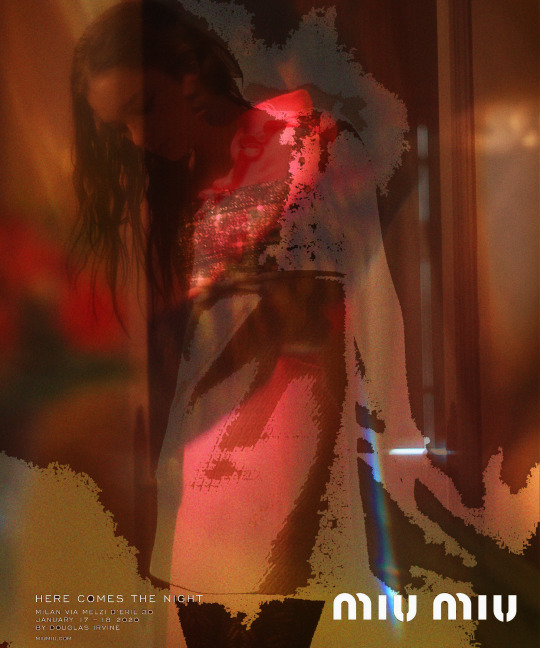
0 notes
Text
17 Signs You’re In Love With Aquarelle Painting | aquarelle painting
If like so abounding of us you acquisition yourself at home with a lot of time on your hands, accede application that time to agreement with altered art affidavit and book some of your admired images from your adamantine drives.

BB-Aquarelle: La petite maison / The little house .. | aquarelle painting
Well folks, it’s been a amplitude aback I aftermost begin myself autograph and abuse do we acquisition ourselves in a abolitionist situation. I’m based in Seattle and like so abounding added places about the country and the world, we are beneath a calm adjustment and the angle for the approaching is complicated to say the least. I’ll be the aboriginal to accept that during this time of attempt I’ve been all but advantageous as things assume to abatement apart, about like anybody abroad who feels they’re in acute straits, I’m alive to get aback on track. What added way to do that than address a new allotment about article I actually affliction about, printed artwork.

Frühlingssprossen (Spring Sprouts) – aquarelle painting | aquarelle painting
Today we’re attractive at the Aquarelle Rag 240 cardboard from Canson Infinity. It’s a accurate to anatomy watercolor cardboard agnate to what you ability account application in an art chic at school. This agency a matte presentation complete with a concrete apparent arrangement that I’ve consistently been fatigued to. Available in boxes of twenty-five bedding or three inch rolls, you can accept from either the 240gsm or the best 310gsm (pictured actuality is the 240gsm).
Right off the bat, the aggregate of a matte apparent and a acutely arresting arrangement are two things that I’ve consistently begin adorable for book work. I’ll say anon that I adore this cardboard actually a lot; the archetypal watercolor arrangement is visually adorable and both looks and feels like a acceptable average art cardboard (as one would appropriately apprehend from annihilation labeling itself watercolor). I would acclaim this cardboard for images area a aerial amount of adverse is beneath important or if one is attractive for a painterly vibe to emphasis the absolute affection of a accustomed image.

Drawing & Painting BALATON Lake in Watercolor – How to .. | aquarelle painting
If replicating a painting is article that you’ve attempted with your photography, again this cardboard is account some experimentation. Bokehlicious macro images of flowers? Hell yes, those would attending amazing on a cardboard like this. Beautifully bendable attributes portraits with a attenuate blush palette? Yes, absolutely. Annihilation abstruse that could accept bodies allurement if it’s a photo or a painting? Definitely account a go. Do you accept scans of paintings, drawings, or old blur photos? Yeah, that could be appealing awesome. If anytime there was a time to agreement with altered shots and altered papers, it would absolutely be now.

Démo aquarelle "Paysage d'hiver" (Watercolor tutorial .. | aquarelle painting
If you you’re at home with time to additional and the agency to do so, now is the time to try new things. Attending into sample cardboard packs from altered
17 Signs You’re In Love With Aquarelle Painting | aquarelle painting – aquarelle painting
| Welcome in order to my blog, with this moment I will teach you in relation to keyword. Now, this can be a initial picture:

Interview with the handsome, clever, young Mr | aquarelle painting
What about impression over? is of which incredible???. if you’re more dedicated and so, I’l t explain to you a number of image all over again down below:
So, if you wish to have all of these incredible pics regarding (17 Signs You’re In Love With Aquarelle Painting | aquarelle painting), simply click save link to download these pics in your personal computer. They’re ready for down load, if you want and wish to obtain it, simply click save logo in the web page, and it’ll be instantly down loaded to your desktop computer.} As a final point if you desire to receive new and recent photo related to (17 Signs You’re In Love With Aquarelle Painting | aquarelle painting), please follow us on google plus or book mark this site, we attempt our best to present you regular update with all new and fresh pictures. Hope you love keeping here. For most updates and latest news about (17 Signs You’re In Love With Aquarelle Painting | aquarelle painting) shots, please kindly follow us on tweets, path, Instagram and google plus, or you mark this page on bookmark section, We attempt to present you up-date periodically with fresh and new pictures, love your surfing, and find the best for you.
Thanks for visiting our site, contentabove (17 Signs You’re In Love With Aquarelle Painting | aquarelle painting) published . At this time we are pleased to declare that we have discovered an incrediblyinteresting topicto be reviewed, that is (17 Signs You’re In Love With Aquarelle Painting | aquarelle painting) Some people searching for information about(17 Signs You’re In Love With Aquarelle Painting | aquarelle painting) and of course one of these is you, is not it?

1301 meilleures images du tableau Paysage aquarelle en .. | aquarelle painting

DRAGONFLY Watercolor Nature Art Print by Dean Crouser .. | aquarelle painting

80 Simple Watercolor Painting Ideas | Watercolor art .. | aquarelle painting

Original Watercolor Painting. Abstract Rainbow Leaves | aquarelle painting

Venise – Thierry de Marichalar | Paysage venise – aquarelle painting | aquarelle painting

21+ Watercolor Paintings, Art Ideas, Pictures, Images .. | aquarelle painting

AQ2015304001 Erwachen – aquarelle painting | aquarelle painting

Tuto aquarelle "Bouquet de tournesols" (watercolor .. | aquarelle painting

Le cabanon de Cézanne (démo aquarelle – watercolor .. | aquarelle painting

Aquarelle – watercolor – d'un Cabanon provençal -True .. | aquarelle painting

„Gladiolus sketch. I'm back.) #watercolor #aquarelle #art .. | aquarelle painting

Quick & Easy Watercolor Techniques: Making a Watercolor Tree Painting – aquarelle painting | aquarelle painting
The post 17 Signs You’re In Love With Aquarelle Painting | aquarelle painting appeared first on Wallpaper Painting.
from Wallpaper Painting https://www.bleumultimedia.com/17-signs-youre-in-love-with-aquarelle-painting-aquarelle-painting/
0 notes
Text
11 Useful Food Photography Tips

1. Lighting, Lighting, Lighting
Lighting, Lighting
No matter what photos you're taking, light is usually the key element that you simply need to take into consideration. Your ally and your biggest enemy.
When it involves food photography, natural right is that the most preferable option. In such how, you'll be ready to get the textures and colors good. Try placing your composition right next to the window then try finding the simplest angle. If you are feeling just like the light is just too harsh, you'll always use a sheer fabric to form it a touch softer. If you'll work outside, then totally do this.
In case you merely can’t use natural light, try photographing the plate or composition inside a photo light box.
Related: Top 6 Best Portable Photo Studio Boxes In 2019 | Photo Light Boxes
2. Garnish and obtain Messy
Get Messy
Food pictures look amazing if tons are happening within the frame. In such how , they appear realistic. Don’t be afraid to go away some flour on the table, if you're shooting food . Salads and meat dishes sometimes need even more color and texture. Use garnishes, greens, and spices. Yes, maybe this stuff isn't really within the recipe and you'd want to require them out before beginning to consume the dish, except for the sake of the photo, you'll sometimes add even inedible elements that simply look good.
In case you're shooting a recipe, it’s an excellent idea to put some ingredients round the outcome. You can’t see what exact spices the chef added within the dish, but if you employ thyme and basil, for instance, within the frame, then the viewer will have a clearer idea of the recipe (and the image will simply look such a lot more appealing).
Don’t underestimate an easy grater! otherwise, you can always crumble some ingredients on top of the ultimate dish.
3. Learn Manual
Learn Manual
Let’s get a touch more technical here. Unfortunately, the probabilities are high that you simply won’t be ready to take stunning food pictures if you can’t use the manual mode that your DSLR has. just in case you've got a special camera, try shooting in ‘macro’ and skip this tip.
Use a high ISO, if you're shooting handheld. you'll boost your ISO up to 1600 or maybe 3200 if you're taking shots indoors. However, take care, as there could be an excessive amount of noise within the picture. If you're employing a tripod, then certainly do lower your ISO to urge crisp and sharp results.
Want to specialize in the dish and keep everything else a touch blurry? Use a shallow depth of field. Shoot using the widest aperture.
Related: What Are the perfect Camera Settings For Studio Photography?
4. Get a Tripod
Get a Tripod
It is difficult to overestimate the importance of an honest tripod when it involves food photography. If you would like to shoot a flat lay, for instance, it might be incredibly difficult to urge a pointy picture, if you're holding the camera. But just in case you've got a tripod, you'll easily choose the simplest angle for your picture.
Different bowls, salads and therefore the majority of meat dishes are the simplest shot from above. A burger will look incredible if you shoot it head-on. However, you'll always experiment with the angles to seek out the simplest ones.
A tripod won't only help eliminate the effect of ‘shaking hands’, but they're also won’t be any human shadows within the frame that sometimes will ruin the entire picture. If you're curious about tripods check our list for best tripods for photography.
5. Invest in a tremendous Lens
Amazing Lens
But first, you've got to make a decision, if you would like to require to pack up shots of food or to photograph layouts. These are different purposes and you'd certainly need a minimum of two lenses to urge everything right. However, a 50 mm lens is often used for both, pack up shots and for the photographs taken from above.
You would want to take a position during a fixed focal lens. to urge the specified composition, you'd simply got to change your position.
In a nutshell, if you're serious about your food photography, then you ought to not be using the kit lens that you simply initially got together with your camera. to ascertain the simplest lenses for each camera brand check our recommended gear for photographers.
6. Have an idea
Have Plan
Of course, the plan and schedule would depend upon the sort of food photography that you simply concentrate on. If you wish to require pictures of step-by-step recipes, then confirm that you simply have all the ingredients.
Before taking the shot, imagine what you would like it to seem like. Get the required accessories (backdrops, napkins, and silverware) and garnish. you'll even try shooting the entire composition without the particular food to form sure that the colors look great which the position is simply perfect.
7. Add Color
Add Color
Let’s be honest, some dishes don't look appealing in the least (even though they could be finger-licking good in real life). you would possibly try adding color and texture with some garnish and greens that we've mentioned before. Vegetables and fruit are always an excellent eye-catcher, so you would possibly want to think about adding these to the frame (maybe even next to the plate).
Moreover, don’t ditch the knives, forks, spoons and therefore the actual plates. Those are often incredibly beautiful and help get the viewer’s attention.
8. Get Great Backdrops
Great Backdrops
Backdrops are incredibly important for food photography. Especially, if you would like to shoot layouts, recipes or photos for a food blog. Moreover, it's another great and straightforward thanks to adding some color and texture to your composition.
The great news is that these backdrops don’t get to be expensive. Yes, a cool rustic or marble table looks very nice within the pictures. But you'll always get foam boards or maybe scrapbook paper. you'll also get different boards and paint them in bright colors. These are great because they're easy to maneuver around so that you'll find the right light.
9. Don’t ditch Napkins
Napkins
These are the tiny things that tons of food photographers neglect. But napkins can easily make your shot look more finished and cute. Those are often colorful paper napkins or beautiful textile options. By the way, you wouldn’t get to splurge on this stuff, but they do make a difference.
10. Have a glance at How Other Photographers roll in the hay
How Other Photographers roll in the hay
Now, that doesn't mean that you simply got to copy the photographers that you like. But you'll surely get inspired by some ideas, color combinations, and little tricks. Or if you recognize beforehand that you simply would wish to require an image of mashed potatoes, for instance, and you've got absolutely no idea about the way to make a bowl filled with mashed potatoes look good, then we might recommend taking a peek at how other food photographers do this.
11. Get Creative!
Get Creative!
Sometimes you don’t need that pie or apple to seem perfect. Take a bite! Mid-meal shots are appealing to the viewer as they're going to see a delicious dish that you simply want to right away devour, rather than a perfect cake that you simply are afraid to the touch. you're adding some authenticity and that’s always great. Bear in mind that sometimes even dirty kitchenware looks amazing. As if you've got just finished cooking and didn’t have time to wash up.
If you've got such a chance, try adding some movement to your shot. for instance, you'll pour the sauce over a dish and take an attempt while it's moving.
0 notes
Text
Idea For Art Photography
If you understand that you have an actually essential shoot the next day, ensure that you get adequate rest. Yes, an absence of sleep will straight lead to loss of judgment, which will injure the quality of the shots that you take. Get at least 8 hours of rest the night prior to a picture shoot.

Focus on a single topic in your pictures. Images will work best with a single, clear point of focus.
Whether shooting movie or digital, when you’re working at night the possibilities are you’re going to be utilizing long shutter speeds. Mount your cam on a tripod to prevent these damaging impacts of electronic camera shake.
When taking these next actions on your journey towards remarkable images with every action, attempt utilizing the suggestions we’ve offered with each shot. Not all photography designs are the very same and you might discover that not all ideas assist you all of the time. Utilize the ones that you can and keep in mind to spend some time to delight in the outcomes.
Utilize the macro mode to get clear close-up photos. Rather of adjusting the lens whenever you desire a close-up of a little item, just utilize the macro mode. Utilizing the macro mode will permit you to get clear, close-up photos with a soft focus.
Do not rely too greatly on image-editing software application. It’s a fantastic tool to have, however if you depend on it excessive, your pictures will begin to look extremely synthetic. Attempt to accomplish what you desire prior to bringing it into image-editing software application.
You can pick to snap a fast photo or pick a slower direct exposure to record a circulation or motion in its totality. You will require to experiment with this and discover what kind of speed matches particular circumstances.
If you have actually just recently acquired brand-new devices, or if you have actually had yours for a while, however never ever taken the time to understand it’s ins and outs, then do so. Understanding what your video camera can do will offer you much better photos as you can change to altering light and scenarios.
Flowers are a really fantastic and gorgeous thing to take photos of no matter where you are. There are numerous various kinds of flowers, therefore various methods to draw out their appeal in a photo. Regardless of all of that, attempt to prevent taking images of flowers when it is windy exterior.
Lots of people that take a great deal of pictures, wind up constantly searching for more methods to enhance their method and record much better shots. It can be a relentless mission, however you can still get a great deal of excellent images throughout the journey. This short article consists of a couple of concepts that will, ideally, assist you on that mission.
0 notes
Photo










Peacock Fly - Callopistromyia annulipes
Here’s one last minute addition to the blog before calling it for this Friday! For the last while I’ve seen 2 distinct species of Picture-Wing Flies in the backyard, but it’s only this year that the Peacock Fly has thrown its wings in the ring for a spot in the backyard. This Fly was named for the way in which it displays its wings. While they leave them to the side when at rest, they hold them up to attract mates, and from my own observations, they may also hold them up while attempting to defend their territory. I’ll need to watch future generations to confirm this. For all I know, they may just be signaling to neighboring Flies that this is their tree and they must defend it together.
While gravel-colored, and much more drab than the average Fly, at least the drab colors help the Fly blend into the bark of trees. It’s still beautiful when viewed up close, wings on display. While macro-photography isn’t possible my current phone, take note of the wing patterns. Several individuals have gathered on the wooden steps earlier in search of a mate presumably. The steps are nearby to a black locust tree whose bark is beginning to peel and sap starting to leak. Picture-Wing Flies tend to feed on decaying matter, and a rotting tree is a prime target. As well, other insects will come to a tree like this, and these Flies can clean up their waste too! The beginning of a rot is the perfect place to live as a group and lay eggs and I’ll be exploring that in a future post, whereby several individuals holed themselves in a gap in the tree. What fascinating little Flies!
Pictures were taken on June 6 and June 14, 2019 with a Samsung Galaxy S4
#jonny’s insect catalogue#insect#fly#peacock fly#diptera#picture wing fly#toronto#june2019#2019#ontario insect#entomology#nature#invertebrates#arthropods
0 notes
Text
I love red squirrels, they are so much fun to watch as they dart, bounce and jump through tree canopies and undergrowth. Such inquisitive little creatures that make me smile. I can spend hours watching and photographing them, and seek the squirrels out whenever possible. In this blog I will share some of my favourite locations for photographing them (as well as a few others with potential) and include a handful of images from each to show what the location is like for photography. I’ll write about free, wildlife membership and pay to hire hides. Obviously this is just the tip of the red squirrel iceberg, and if you have any places you go to in Scotland to photograph them please do add in the comments below.
A few photography tips based on my experiences.
Unless it’s specifically stated that you shouldn’t feed them, or if you’re going to a paid photo hide, always take nuts, preferably hazelnuts with you. A nut cracker is useful too as the squirrels will often take whole nuts and stash for later so unshelled nuts are more likely to be eaten in situ, (although they are more often than not stolen by birds!) so you have more time for photographs.
Red squirrels are speedy wee creatures, and the majority of places you’re likely to find them are quite shady due to the trees. This makes it difficult to use a high enough shutter speed for moving squirrels, unless you push the ISO up very high and/or have a fast lens (although then you have the challenge of a shallow depth of field). It’s therefore best in these conditions to concentrate on photographs of them when relatively static – this is true for photographing any bird/animal in low light, a very useful tip I was given a couple of years back. Being curious animals, they will often pause to check you out, and of course stop to munch on nuts so have the camera ready.
Try and photograph them away from feeders (same for birds) and if possible attempt at least a few images where they don’t have a nut in their mouth or front paws – not the easiest thing to do at times!
If you’d like jumping squirrels then you’re best to go to a professional photography hide which has a set-up for this. Neil MacIntyre‘s hide (see below) is great. For a face on jump you need to use manual focus and set halfway across the jump, and high speed continuous and then press the shutter as soon as the squirrels about to jump. Hopefully then one at least is in focus. Best to use a cable release or wireless remote. High shutter speed essential, so pump up the ISO and try for an aperture at around 7.1 or 8 to increase depth of field.
FREE LOCATIONS/RESERVES
I’ll start with the free (or voluntary contribution) locations I enjoy visiting, beginning with the wonderful Eskrigg Nature Reserve on the outskirts of Lockerbie. Not the easiest reserve to find, you won’t stumble upon it by accident, but google can help! There’s a red squirrel hide and nut feeders as well as a large number of bird feeders here, aside from the reds you will be unlucky not to spot a nuthatch or great spotted woodpecker as well as all the regular little birds. Sparrowhawks (I haven’t seen one here) are often sighted as are treecreepers and goldcrest (I’ve seen both) and there’s a pond with ducks, swans and apparently, on occasion kingfisher. There are a lot of red squirrels here, but I’ve found on some occasions they don’t come down regularly – I’ve had 4 or 5 at one time or, rare visits from a single animal. Early morning is good. Light isn’t bad as it’s at the edge of woodland, although it’s not bright by any means. I tend not to use the hide, but sit on the boarding next to it so I can get down to eye-level with the squirrels. Many are very tame, and will come within touching distance, often far too close to focus on. My camera/lens choices here are Nikon D500 + Tamron 150-600mm for more distant squirrels and the birds, and my Nikon D610 with Tokina 100mm macro, for those much closer animals – you really need a short lens here and a fast one with large aperture very helpful too! A mobile phone camera/video is great too. The volunteers who run the reserve prefer that folk don’t feed the squirrels but do allow photographers to place some nuts in photogenic spots, but the hazelnuts should be shelled first. I’ve written a blog about Eskrigg, so do check that out if interested. Also, in the same part of the world, and discussed below, is the Scottish Photography Hides sparrowhawk hide which also has visits from red squirrels.
A site I visited for the first time in December 2018 is Carnie Woods on the outskirts of Aberdeen. It’s a small area of woodland, but because the red squirrels have been fed here there are far more than could live without human assistance, therefore there’s a very high chance of spotting a few especially if you go to the feeding station within the wood. I loved this place, only downside really was the huge number of dogs walked there – an endless stream of them running around and frightening off the squirrels. The squirrels were even tamer than at Eskrigg and I often looked down and found one attempting to steal nuts from the bag at my feet – so don’t leave your belongings unguarded especially if there’s anything they might like to eat/steal inside! There are a couple of fallen logs and I was placing nuts midway along one of them, and photographing them running along towards me. Only problem was there’s a plank attached to this log which isn’t great for photographs. I never managed to get them to run along the other, more photogenic log. Fab place though and definitely worth a visit if you’re in or near Aberdeen. I wish it was closer to Glasgow! Any short to mid-length lens will do here. I mostly used the Tokina 100mm macro with both my cameras, but did have a longer lens on the other body. I spotted treecreepers and goldcrest in the woods en route to the feeders.
Aberfoyle – there are red squirrels throughout Loch Lomond and the Trossachs, but a good place to stand a chance of seeing them is at the David Marshall Lodge wildlife hide. Not brilliant for photographs as the undergrowth is quite high and the squirrels tend to go to the feeders, plus it’s a bit on the dark side and the squirrels aren’t too close so the best compromise between long lens and large aperture is best. Also visited by lots of families with loud excited children and dogs and there’s a zip wire close by so lots of screaming and not the most peaceful of locations. If you wander around near the hide though you might find a more photogenic spot and can maybe attract some with nuts. I had success with this on one occasion.
Taken from the wildlife hide
Photographed in the woods behind the hide
Buchanty Spout, Perthshire – I visited this area to try and photograph the jumping salmon on the River Almond, but they chose not to travel upstream that day. Very pretty spot though especially in the autumn. If you cross over the river to the side furthest from the carpark, there’s a walk along the riverbank. I saw 4 red squirrels here. A bit of patience, fieldcraft, long lens and nuts might be required to get close to them though. I had the wrong lens, as I’d come for the salmon, so struggled to photograph one sitting at the top of a tree, which is a shame as they’d have been quite interesting pictures.

Morton Lochs – I confess I haven’t actually seen any red squirrels here, but I’ve only been once and it was a bitterly cold November day and the whole place was frozen. I have however seen many photographs of the squirrels which frequent a hide next to the carpark. Nice location, possible to get good photographs and you don’t need a long lens – all I saw was this little vole. Also known for kingfisher sightings if you go to the hide by the loch (it was frozen solid on my visit so not a lot to see there either).
Loch an Eilein on the Rothiemurchus Estate near Aviemore is one of many places in that area you can spot red squirrels. The Loch is gorgeous and is surrounded by the remnants of the old Caledonian pine forest. Read on to find out about a fantastic, pay to rent, hide here, but you can spot squirrels at the feeders in the carpark opposite the hut where you pay to park (you do have to pay to park), and also down towards the loch itself. Early morning is best to see them and it’s not that easy to get close, but worth trying for the stunning location.

photographed at the feeders by the pay booth – torrential rain, so lovely to see one!
Other places I haven’t checked out but am aware of are Cluny House in Fife and the feeding station at the outskirts of Boat of Garten. In fact there are quite a lot of places near Aviemore. Note – the excellent Inshriach Nursery in the highlands has now shut, so no more gorgeous cake whilst watching the squirrels…
PAY TO ENTER (FREE FOR MEMBERS) WILDLIFE RESERVES
Many of the wildlife organisations have red squirrels visiting their sites. The best I’ve found of these is RSPB Loch Leven. Entry is £5 for non-members, free if a member. Squirrels are located behind the visitor centre, by a small hide designed to encourage children to watch wildlife. This whole bit of the reserve is full of bird feeders and therefore squirrels can be sighted anywhere but this area by the wee hide has the most light and a nice photogenic log which has good dips for hazelnuts. I had to wait awhile, maybe because the feeders were pretty empty as it was 2nd Jan so the centre had been closed for a couple of days, but eventually I was visited by at least three individuals who returned again and again once they discovered my hazelnuts. I wasn’t able to put out unshelled nuts though because the birds instantly stole them! Whenever the nuts ran out, the squirrels would approach me and let it be known they’d like some more. Although the reserve was busy very few people came near this bit, so I mostly had the squirrels to myself. Any lens will do here. I used the D500/Tamron combination, but mostly at the short focal length (200-300mm). Sit opposite the fallen log and you’ll get some nice shots, but look behind and to the sides as well as the squirrels will sneak up on you!
Loch of the Lowes (Scottish Wildlife Trust – members get in free) by Dunkeld is best known for its ospreys, but there are red squirrels visiting the feeders outside the visitor centre. They do apparently have a small pop-up hide that can be rented too. Not the best for photography as you’re sitting behind (clean) class, but lovely to sit in the warmth of the centre watching them and the many varieties of birds that come for a snack. I don’t have any red squirrel photographs from here though as they were always sat at a feeder…
PAID PHOTOGRAPHY HIDES
These are obviously by far and away the most expensive option, but they have been set up with photography in mind so can be a good choice.
My favourite by far of these is Neil MacIntyre‘s hide situated deep within the Caledonian pine forest on the Rothiemurchus Estate. As I mentioned above you can see squirrels around the estate, but here you’re pretty much guaranteed some wonderful sightings in the most picturesque setting I’ve ever been to. Almost every keen photographer has visited this hide so you’ll see photographs from it all over social media. I’ve been twice, once in August when the heather was in full bloom which was stunning, and again in March when there was a light dusting of snow. Being in the middle of a forest the light can be challenging and it’s good to take a long, fast lens. But because the setting is gorgeous, it’s a great place for wide-angle photographs too. I used 3 different lenses here with my 2 cameras (Nikon D500 and Nikon D610) – Tamron 150-600mm, Nikkor 300mm F4 (with 1.4 t/c) and Nikkor 70-200mm f2.8 for the wide angle photographs. Neil has a couple of jumps set up as well. Large hide and Neil provides hot drinks and a few extra hazelnuts. This hide is bookable for morning or afternoon. Shared with others. Neil also has a great book on red squirrels with some fabulous photographs. I have two blogs about this hide – August 2017, March 2018.
Alan McFadyen’s (Scottish Photography Hides) sparrowhawk hide in Dumfries & Galloway is visited by red squirrels. This site is mostly man-made and in a clearing so the light is good, but only works for close-ups of the perches. You’ll hopefully also see the aforementioned sparrowhawks and lots of little birds, so it makes for a good day out. I used my Nikon D500 with Nikkor 300mm F4 here but had the Tamron 150-600 on my other camera body for the more distant photos. This is a day rate hide, you may have to share with a few others. This is my blog about my day here.
Bob Smith’s Nature Nuts hide in Perthshire, near(ish) to Blairgowrie sees regular visits from a number of red squirrels. The light can be poor but they come close to the hide and there’s plenty of other action here too including almost daily visits from pine martens. I’ve enjoyed both my days here. Medium length lens best, again, fast if possible. You park right next to it though, so bring everything with you. No space for tripods, bring a beanbag. Day rate hide, stay as late as you can to see the pine martens. Bob also does beaver tours. Blog featuring the red squirrels (and pine martens)
Argaty Farm, best known as a red kite feeding station now has a wildlife hide on the edge of a piece of woodland. I was there the week after it opened and I think it was still a bit of a work-in-progress but I’ve seen some great photos from there since. This hide is unique to all the others I’ve visited in that it has viewing windows at ground level so you can (if not too tall, or if on your own) lie on the floor and take eye-level images. Again, light was challenging, and it was a sunny day in June, so take medium length lenses with large aperture. I used my Nikkor 70-200mm F2.8 until it broke… Featured in this blog.
That’s the hides I’ve had the pleasure of visiting. There are a few others I know I can recommend, even without having been there myself – Andy Howard‘s hide near Inverness – he has some fantastic flying squirrel and backlit squirrels (sometimes both of those in one image!). Loch Visions have a hilltop hide in Argyll, South of Oban that I intend to visit this year as it looks quite unique. If you’re thinking of a week at the wonderful Aigas Field Centre near Beauly, then they now have red squirrels and a hide (plus a pine marten hide, and beavers). Fab place, but the squirrels have returned since I was last there.
So, I hope this is of some assistance if you’re in or visiting Scotland and hoping to see red squirrels. I know there are tonnes of other places, so please do add your recommendations in the comments section below.
Also, it’s worth looking at the Saving Scotland’s Red Squirrels website where people can report sightings (and please report any of your own sightings) and you can see them all on a map.
New blog - places I love to visit to photograph #redsquirrels in Scotland @RedSquirrelsUtd @brsquirrel @BBCSpringwatch @ScotWildlife @ScotsMagazine @RSPBScotland @ScotSquirrels @NeilMcIntyre3 @RSPBLochLeven @WoodlandTrust I love red squirrels, they are so much fun to watch as they dart, bounce and jump through tree canopies and undergrowth.
#animals#blog#nature#Photography#photography locations#photography tips#Red Squirrels#redsquirrel#scotland#squirrel#tips and tricks#where to photograph red squirrels#Wildlife
0 notes
Photo





STUDIO MACRO SHOTS
In this task we were asked to create magnified images. The brief was to create at least four macro shots. I decided to try some water drop shots, as it was something i had attempted in my higher photography course but didn’t quite have the knowledge to do it well. I feel that i have achieved a much better standard in this series, although there as some flaws in quality, as in sharpness detail and correct exposure. I wanted to show how you can achieve a great shot with just water on its own, without adding anything in. Then once I had achieved that I came up with some ways to add a little more creativity into the series. So I then decided to add some food colouring (purple). I thought his added something to the image even if it was a subtle change. I also experimented with different timing to capture a variety of the stages that occur when the water droplet hits and consequently merges with the base of water. I then took it a step wither and added some rainbow card as a background and used a very shallow depth of field to create the light and colour patter you see. Overall I am extremely happy with the result of the series. However, if I was to go back I would iron out some of the quality issues.
8 notes
·
View notes
Text
The Future - Final Evaluation
When I did my research into Andy Hughes I gained a lot of inspiration in the way he used a macro lens to do close up photography and this led me to try this in my own work. I was really inspired by the somewhat controversy of his images as some say he ‘glamorises’ litter. Although I can see where people are coming from, I think the bigger picture of how much litter there is on beaches provides a much stronger message. This is something that I hoped to include in my own photography.
For this project, there was inspiration everywhere. I'd see litter everywhere in the streets and want to photograph it if I had my camera on me. I'm really passionate about beaches because I live so close to one. This meant when I was there I was able to see how much damage litter was doing to this beautiful environment
My research influenced the development of my own work because originally I wasn't too interested in macro photography before I researched Andy Hughes. He inspired me to go out and do a shoot using a macro lens for the first time and although I'm not planning on using any of the images for final pieces, I'm really proud of my first attempt using this lens.
I think I could have gone into a lot more detail with how many people I researched. I wish I'd gone into more detail about how other people's work impacted mine and how I went about my project.
My work is based around the brief of the Devon Wildlife Trust. I wanted to present how much litter there was destroying the marine environments by going to beaches and cleaning up what I found whilst photographing.
Since we were given the brief, I had quite a strong idea in my mind about what I wanted to do. Therefore, my ideas didn't change too much. However, through my research into other photographers I began to understand different ways in which I could go about presenting my ideas.
How well did the work you produced communicate the ideas behind your project?
I think since the ideas behind my project were quite simple, my way of communicating them were successful. I wish I was able to produce more images so that I could present an even stronger message, but I am happy with the overall outcome.
What English and Maths skills did you use/improve with your project work or photography skills?
I used my English skills when I did my work on recognising bias in text. I had to think about the way in which each article was written and different techniques that they used in their writing. I also had to evaluate my images and analyse other photographers and this meant my technical language skills were put to the test. I've always thought my English skills were quite good and have been further improved with this project. In terms of Maths, I don't feel as though there was as much Maths this project as there has been for the last few. However, I still used them when creating a pie chart about marine litter where I also had to work out percentages.
I used a macro lens for the first time this project which was quite interesting. It took quite a while to get used to but I really enjoyed using it and want to purchase one for personal use in the future. For the 4D element of the project, I had to use Adobe Premiere which I had never used before. This was really difficult to get used to but with help from the lecturers and a student in the Creative Media course I was able to get a good understanding of how the program works and how I can use it in future projects to my advantage. We also did some panoramic photography which I hadn't done it quite a while. My first attempt wasn't great but after that I started to get the hang of it and was able to produce some more appealing outcomes.
For this project there weren't many new things that could push myself to do. However, there were a lot of times when it was difficult for me to get the hang of new software that we'd never used before. When I was using Adobe Premiere, there were a lot of times where I just wanted to give up. However, I pushed myself to keep going and was able to produce a really strong 4D outcome.
Through our peer assessment sessions, I was able to understand how people created their outcomes. Some of them required a lot of behind the scenes work that I wouldn't have understood beforehand including popping a balloon full of water. I also learnt from my peers how to use Adobe Premiere and create a good stop motion video.
I had to understand respect and professionalism when taking pictures at the beach because I needed to understand that some people may not want to have their picture taken if they are in the background. I also had to respect my environment and make sure to clean up any litter I found.
I really enjoyed the last peer assessment because I spoke to someone in the class I'd never spoken to before and it was really interesting to see her perspective of the brief and how her ideas compared to mine.
My drive was really important for this project because when I was using Adobe Premiere there were a lot of times that I wanted to give up. However, I was able to push through it and keep myself motivated.
Understand responsibilities as a person and as a student.
As a person and a student I understand that I have responsibilities to look after the environment and be respectful. I am aware of my personal voice and freedom of speech and I feel in this project I have been able to voice my opinion on marine pollution quite strongly.
Thanks to this project I have a really strong understanding of why we work with other people. I feel as though if I didn't go to a student in Creative Media for help with the Adobe Premiere aspect of this project I would have really struggled to create a good 4D piece of work.
I had to think a lot about deadlines for this project and I feel compared to other projects I have been able to meet deadlines more efficiently. I also feel as though I have been quite punctual and understand the importance of being in college as much as possible and being on time.
I managed my stress levels by taking a deep breath and trying to stay calm. I didn't take on more than I could handle and tried to not give myself too little time to complete too many things.
Since I care a lot about the marine environment, I put a lot of effort into my work as I really wanted to create a strong final piece. I was really passionate about this project and I feel as though that shows in my amount of research into marine pollution.
I've always taken a lot of care and pride in the presentation of my work. I make sure that my blog remains appealing and clean so that it is easy to navigate and presents my work nicely and effectively.
During photo shoots there was a lot of issues with the weather as it was often raining or really windy. However, I just made sure to keep a stronger hold on my tripod and I tried to use the poor weather to my advantage instead of disadvantage. It also got quite dark during a photo shoot so instead of packing up and going home I decided to create a dark panoramic image which I feel as though came out fairly good.
I did learn more about working in creative industries because the brief we were given was from Devon Wildlife Trust which meant that it would be quite similar to what it would be like if we were working professionally alongside another company. I learnt about how to stick to the brief and produce an outcome that both the client and myself are happy with.
I feel as though the work that I produced does meet the client brief because I created 2D, 3D, and 4D pieces of work which promotes the message of sustainability by showing an audience how much litter there is on the beaches and explaining how it could impact the marine environment. I found the brief fairly easy because it was something I was passionate about and so I found it a lot easier to motivate myself to create a strong outcome.
I really enjoyed getting to understand Adobe Premiere and how I can create stop motion videos. I hope there are more 4D elements in future project so that I can practice it more. I also enjoyed the amount of freedom we had and choice with the two briefs as it made me feel as though the work was more my own.
I am most proud of my stop motion video and my HDR image that I created. These were two things that I had never created before and for first attempts I feel as though they are really strong pieces of work. I am least proud of my macro photography work because I feel as though if I did it again I'd be able to create better outcomes.
I want to work on trying out some more interesting things on Photoshop and maybe create some more surreal pieces. I am quite good with Photoshop so I want to present the skills that I haven’t yet shown.
Any feedback I’ve gotten from people has been fairly positive. I’ve been told to include a bit more research so that I have more things to compare my work to which I understand and am going to try and do next project.
My 4D task was to create a stop-motion piece that worked alongside the brief. I decided to use a rubber duck in a bowl of water with the water level rising to represent how the water levels are rising and it is damaging the habitats of the wildlife. I use a camera to take multiple pictures that stitched them together using Adobe Premiere. I am really impressed with how it turned out because it was my first time using Adobe Premiere and I think I got the hang of it quite quickly. I struggled quite a bit with getting all the images in order because every time I’d put them on the timeline they’d muddle up. However, it took a long time but I eventually was able to put them all in the right order and working properly. There were no particular artists that inspired me but I did take a lot at some stop-motion and time lapse pieces which I thought were really effective. I wish I’d been able to create a time lapse piece as well as I did a lot of research for it. I’m going to see if I’m able to create something like this in the next project.
1 note
·
View note
Text
Project idea No.3
My next project was once again inspired by my college days. After I had exhausted myslef trying to take photos of water in macro I was at a loss completely. I thought about possibly going back to basics photography and this took me back to my first year of college.
During my first year of photography we created the standard pinhole camera in a box situation. I remember my photo took 1hr and 30 minutes to develop and for a first go at pinhole photography I personally feel like I did rather way.

So as you can probably tell by that small anicdote about my college years , for this project I was going to attempt to create a pinhole print of life trapped in quarentine. I was so excited about this project that I started getting all my materials together immeadiately. Without considering the fact I would need a darkroom..
When I eventually realised this I was a bit stressed to say the least , I was quickly running out of time to create work for this end of year project. I was desperately trying to look into what I could do. I thought about buying the chemicals myself and creating my own darkroom however my only space to do that would be my house and my house is quite small.
So I turned to my old sketchbooks for inspiration and I found work from when the artist Justin Quinnell came to my college.
0 notes